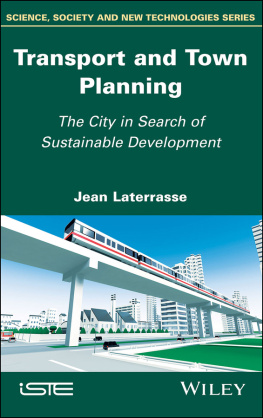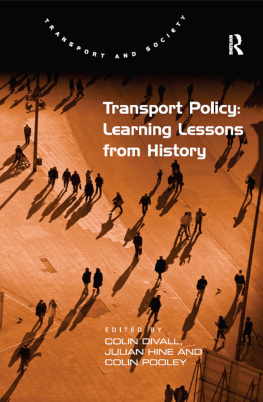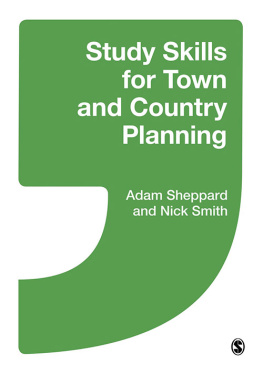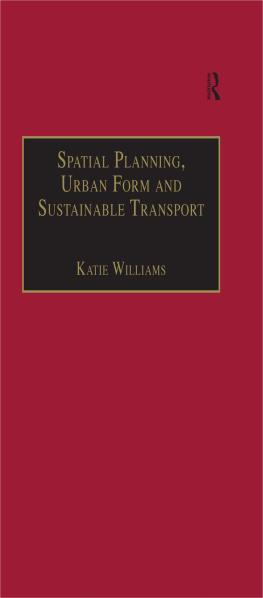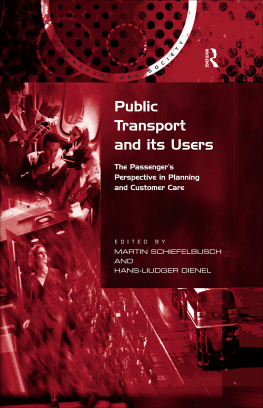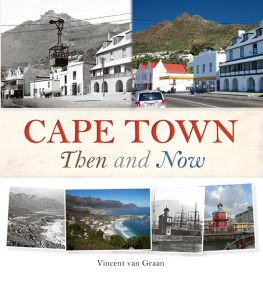Laterrasse - Transport and Town Planning
Here you can read online Laterrasse - Transport and Town Planning full text of the book (entire story) in english for free. Download pdf and epub, get meaning, cover and reviews about this ebook. year: 2019, publisher: John Wiley & Sons, Incorporated, genre: Computer. Description of the work, (preface) as well as reviews are available. Best literature library LitArk.com created for fans of good reading and offers a wide selection of genres:
Romance novel
Science fiction
Adventure
Detective
Science
History
Home and family
Prose
Art
Politics
Computer
Non-fiction
Religion
Business
Children
Humor
Choose a favorite category and find really read worthwhile books. Enjoy immersion in the world of imagination, feel the emotions of the characters or learn something new for yourself, make an fascinating discovery.
- Book:Transport and Town Planning
- Author:
- Publisher:John Wiley & Sons, Incorporated
- Genre:
- Year:2019
- Rating:3 / 5
- Favourites:Add to favourites
- Your mark:
- 60
- 1
- 2
- 3
- 4
- 5
Transport and Town Planning: summary, description and annotation
We offer to read an annotation, description, summary or preface (depends on what the author of the book "Transport and Town Planning" wrote himself). If you haven't found the necessary information about the book — write in the comments, we will try to find it.
Transport and Town Planning — read online for free the complete book (whole text) full work
Below is the text of the book, divided by pages. System saving the place of the last page read, allows you to conveniently read the book "Transport and Town Planning" online for free, without having to search again every time where you left off. Put a bookmark, and you can go to the page where you finished reading at any time.
Font size:
Interval:
Bookmark:

To Th.B. Aw and M. El-Hadeuf, with all my thanks for your contributions
Jean Laterrasse

First published 2019 in Great Britain and the United States by ISTE Ltd and John Wiley & Sons, Inc.
Apart from any fair dealing for the purposes of research or private study, or criticism or review, as permitted under the Copyright, Designs and Patents Act 1988, this publication may only be reproduced, stored or transmitted, in any form or by any means, with the prior permission in writing of the publishers, or in the case of reprographic reproduction in accordance with the terms and licenses issued by the CLA. Enquiries concerning reproduction outside these terms should be sent to the publishers at the undermentioned address:
ISTE Ltd
27-37 St Georges Road
London SW19 4EU
UK
www.iste.co.uk
John Wiley & Sons, Inc.
111 River Street
Hoboken, NJ 07030
USA
www.wiley.com
ISTE Ltd 2019
The rights of Jean Laterrasse to be identified as the author of this work have been asserted by him in accordance with the Copyright, Designs and Patents Act 1988.
Library of Congress Control Number: 2018962334
British Library Cataloguing-in-Publication Data
A CIP record for this book is available from the British Library
ISBN 978-1-78630-329-5
This book is based on the observation that a double division marks the theories and practices implemented in urban manufacturing: division between town planning and transport, followed by division between engineering and social sciences. Although these divisions are particularly significant in France, they do not concern France alone but are found in various forms on the five continents, and they today constitute obstacles to progress with the necessary scale and pace towards sustainable urban development.
Taking the opposite view of these reductive cleavages, this book is built around a dialog between these different fields. This dialog is essential today to meet the challenges posed by our contemporary cities. Systemic analysis, on the one hand, and the historical approach integrating the teachings of the last two centuries of urban history, on the other hand, constitute at the methodological level the framework within which this dialog takes place. Conceptual models are used where necessary, but by always explaining the underlying assumptions and opening the black boxes to allow readers who do not have particular engineering knowledge to understand the origins and scopes of application (including the limits) of the models used. From this perspective, the book integrates the long pedagogical practice that I acquired while directing a masters program that included third year students of top engineering schools as well as architecture students and urban planners in their final year of study.
As a result, this book is intended for students as well as practitioners, for engineers as well as urban planners or managers of our contemporary cities. Its primary purpose is not to provide general and definitive responses, which would seem particularly illusory and inappropriate in the contexts of the great diversity that we all know, but points on which to reflect and tools to better communicate and jointly find, far from normative paths, ways for the future.
With the above being the objective, this book is fueled by many borrowings and exchanges that I managed to have throughout my professional adventure, and different functions that I had the opportunity to carry out, in higher education and research, but also in operational positions. To remain within the recent period, I would like to thank especially my colleagues from the Laboratoire Ville Mobilit Transport (LVMT) for their contributions. This laboratory, on the campus of the Cit Descartes in Marne-la-Valle, has the particularity of prospering at the crossroads of three cultures: that of the Ecole des Ponts, that of the French National Institute for Research into Transport and Transport Safety (which later became the Institut Franais des Sciences et Technologies sur les Transports, lAmnagement et les Rseaux (French Institute of Science and Technology on Transport, Planning and Networks)) and finally that of the Universit Paris Est and its school of urban planning. I equally extend my gratitude to all colleagues from the Energy Transition Institute Efficacity where I work today, and especially its Director M. Salem-Sermanet, who allowed me to carry out these exchanges in a particularly stimulating environment in tune with the theoretical and operational issues involved in the development of decision support tools adapted to the challenges of the contemporary city.
My special appreciation also goes to the Masters students of Transport and Planning, common to the Ecole dUrbanisme of Paris and the Ecole des Ponts. This book largely reproduces the course that they helped me to prepare, through their questions and also by the richness and diversity of their contributions, often drawn from case studies backed by some 20 countries from which they originate. Many names come to mind. Many of them with whom I maintained contact occupy important functions today. I have limited myself to mentioning throughout the text only those whose end-of-course dissertations or theses occupy some parts of this work, with a particular mention for Th.B.Aw and M.El Hadeuf who helped me to build respectively , but my gratitude goes far beyond and concerns the 15 or so batches I had the pleasure of accompanying.
A very warm thank you to all. I reserve a special thanks to P. Devoyon, without whom I would not have succeeded in formatting the manuscript, and who provided his assistance with great relevance and kindness.
While I benefited for the drafting of this book from many contributions, and that notwithstanding, I acknowledge the responsibility for the positions adopted herein. I
tried to support them with as rigorous a scientific and ethical approach as possible, deeply inspired by the conviction that urban transition will only be made with all stakeholders of the city, in particular citizens, with the latter being able to intervene at every decision-making stage.
If is up to you to appreciate if this book, as I hope, can contribute to it.
Jean LATERRASSE
November 2018
City and Complexity: How to Untangle the Skein?
Reflecting on cities and their future quickly leads to a paradox: for a large majority of us, the city is a familiar object, within which we quite easily identify our roots. However, thinking and managing the city is nonetheless a very complex exercise. How can what sounds simple in common sense be at the same time so complex, not to say inextricable, to practitioners and managers? To support our observation, it seemed useful for us to discuss this paradox.
The concept of complexity is not trivial, although it can be concealed, as is the case with the object city, under a deceptive simplicity. Within the meaning understood here, this concept is in fact quite recent.
In the late 19th and early 20th Centuries, the history of ideas was marked by a linear vision of progress. In the field of knowledge, it is illustrated by positivist thought: at the same time that it proclaims the supremacy of experimental sciences, it also claims to reduce them to data only accessible by experience and critically underestimates the role of theories. With regard to society, this vision is based on the conviction that economic development, even unequal, benefits everyone and constitutes a kind of royal road to the wellbeing of humanity. The industrial revolution earmarked the triumph of machinery, which was extolled by positivist thinkers, and found in Taylorism a form of organization which seemed to foster such unlimited economic growth and opened to humanity the path of universal progress. At the same time, we are convinced of the almost inexhaustible nature of natural resources, and of the possibility for the economy to develop at the pace of the ability of our societies to transform fossil resources into energy.
Next pageFont size:
Interval:
Bookmark:
Similar books «Transport and Town Planning»
Look at similar books to Transport and Town Planning. We have selected literature similar in name and meaning in the hope of providing readers with more options to find new, interesting, not yet read works.
Discussion, reviews of the book Transport and Town Planning and just readers' own opinions. Leave your comments, write what you think about the work, its meaning or the main characters. Specify what exactly you liked and what you didn't like, and why you think so.

